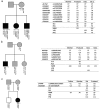Next-generation DNA sequencing identifies novel gene variants and pathways involved in specific language impairment
- PMID: 28440294
- PMCID: PMC5404330
- DOI: 10.1038/srep46105
Next-generation DNA sequencing identifies novel gene variants and pathways involved in specific language impairment
Abstract
A significant proportion of children have unexplained problems acquiring proficient linguistic skills despite adequate intelligence and opportunity. Developmental language disorders are highly heritable with substantial societal impact. Molecular studies have begun to identify candidate loci, but much of the underlying genetic architecture remains undetermined. We performed whole-exome sequencing of 43 unrelated probands affected by severe specific language impairment, followed by independent validations with Sanger sequencing, and analyses of segregation patterns in parents and siblings, to shed new light on aetiology. By first focusing on a pre-defined set of known candidates from the literature, we identified potentially pathogenic variants in genes already implicated in diverse language-related syndromes, including ERC1, GRIN2A, and SRPX2. Complementary analyses suggested novel putative candidates carrying validated variants which were predicted to have functional effects, such as OXR1, SCN9A and KMT2D. We also searched for potential "multiple-hit" cases; one proband carried a rare AUTS2 variant in combination with a rare inherited haplotype affecting STARD9, while another carried a novel nonsynonymous variant in SEMA6D together with a rare stop-gain in SYNPR. On broadening scope to all rare and novel variants throughout the exomes, we identified biological themes that were enriched for such variants, including microtubule transport and cytoskeletal regulation.
Conflict of interest statement
The authors declare no competing financial interests.
Figures




References
-
- Tomblin J. B., Records N. L. & Zhang X. A system for the diagnosis of specific language impairment in kindergarten children. J Speech Hear Res 39, 1284–1294 (1996). - PubMed
-
- Bishop D. V., North T. & Donlan C. Genetic basis of specific language impairment: evidence from a twin study. Dev Med Child Neurol 37, 56–71 (1995). - PubMed
Publication types
MeSH terms
Grants and funding
LinkOut - more resources
Full Text Sources
Other Literature Sources
Miscellaneous

